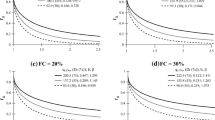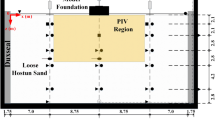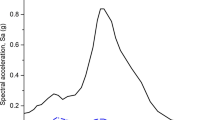Abstract
The performance of near-surface geosystems during earthquake shaking depends on the free-field response of the soil layer and soil–structure interaction mechanisms. This paper presents a brief summary of the variables involved in considering the free-field response of partially saturated soil layers, and provides a step-by-step procedure to estimate the seismic settlement of a soil layer with a given initial relative density and degree of saturation. The procedure, which has been validated in a previous study using centrifuge physical model tests, was tabularized and presented in a flow chart. This methodology was followed to estimate the seismic settlement of different sand layers having different initial relative densities. It was observed that the degree of saturation has the greatest impact on loose soil layers, which also show the greatest amount of seismic settlement. However, partially saturated soil layers resulted in lower seismic settlement compared with dry or saturated soil layers.
Similar content being viewed by others
Explore related subjects
Discover the latest articles, news and stories from top researchers in related subjects.Avoid common mistakes on your manuscript.
Introduction
One of the main variables that needs to be predicted as part of a seismic performance analysis for a geotechnical system is the seismically-induced settlement of a representative free-field soil layer. Although several studies have been conducted in this research area leading to the proposal of several empirical procedures, they have focused on soil layers in dry or water-saturated conditions [1–4]. However, recent studies have emphasized the importance of understanding the influence of partial saturation on the seismic response of soils [5–8]. Since soils near the ground surface are typically partially saturated, it is important to have an inclusive methodology to incorporate the degree of saturation in seismic analyses. Although partially saturated soil layers may not represent the worst-case scenario regarding their settlement response during earthquakes, an understanding of the role of degree of saturation on the seismic settlement of soil layers may help explain why some geosystems behaved in a certain way during an earthquake, and may ensure that seismic designs are not over-conservative considering the local soil stratigraphy, water table depth, and climatological setting.
Ghayoomi et al. [6] adapted and combined a set of available procedures for prediction of the seismic settlement of dry and saturated soils to develop an empirical methodology for estimation of the seismically induced settlement of partially saturated soils. Specifically, they combined empirical relationships for the volumetric seismic compression of soil layers due to collapse of air voids during shaking εv-compression, with empirical relationships for the post-shaking consolidation due to dissipation of excess pore water pressure εv-consolidation. The methodology comprised of synthesizing the recorded data from the literature in an uncoupled formulation using an iterative approach based on that of Silver and Seed [1]. Then, the predicted settlements were verified using the results of centrifuge physical modelling tests [5, 6]. The purpose of this technical note is to delineate the steps in this methodology in a simple and organized manner using a flow chart so that they can be readily applied in practice, and to show how the results of this methodology for sand layers having various initial densities and degrees of saturation. In addition, the flow chart helps outline the areas that require further research in order to populate the empirical data in the methodology.
Background
Early studies on seismic compression focused on the response of dry soils under earthquake shaking and the consequent settlement [1, 2]. Pradel [4] summarized and simplified these efforts into an empirical formula incorporating the effective induced shear strain, γ, soil relative density, Dr, and equivalent number of cycles that correspond to the earthquake magnitude, N. Determining the induced shear strain is a major challenge which is correlated with the effective shear modulus that is a function of the effective shear strain characterized through the modulus reduction function G(γ), small strain shear modulus, Gmax, peak surface acceleration, amax, initial overburden stress, σ, and some sort of depth-dependent reduction function for the induced stress, rd. Later, Tokimatsu and Seed [2] presented the data from a set of cyclic tests on water-saturated soils to estimate the consolidation settlement due to dissipation of excess pore water pressure. They used their data to define relationships between the ratio of generated excess pore water pressure and the initial effective stress, ru, soil relative density, Dr, overburden pressure, σ, and liquefaction induced volume change. Although their model is useful, the pore water pressure generation during shaking and the conditions leading to liquefaction must be considered empirically [9–11]. Specifically, the induced excess pore pressure ratio is obtained through empirical graphs as a function of equivalent number of cycles to the number of cycles required for liquefaction, N/NLiquefaction, at any given cyclic stress ratio, CSR [9–12].
Partial saturation can affect almost all the above mentioned parameters and relations either directly or indirectly through the effect of effective stress. Recent studies have shown via comparisons between experimental results from shear strength and shear modulus tests and analytical predictions that the effective stress in unsaturated soils can be estimated as the sum of the net stress, σ–ua, and the suction stress, σs [13, 14]. These studies have shown that the fitting parameters of the SWRC model of van Genuchten [15], i.e. αvG and NvG, can be used to estimate the suction stress as σs = Ses, where Se is the effective saturation and s is the matric suction (ua − uw; the difference between pore air and pore water pressure) [13, 14]. The major challenge in this process is when the degree of saturation plays a direct role in the response. This includes its effect on the collapse of voids space, pore pressure generation, and liquefaction resistance. Ghayoomi et al. [6] used the liquefaction resistance data [3, 11] and simplified linear void space relations to address these issues. However, further investigations, experimental data, and analytical developments are needed to fill this gap and provide unique relations for unsaturated soils.
Analysis Procedure
Based on the procedure developed by Ghayoomi et al. [6], a flow chart was developed to highlight the step-by-step methodology that should be followed to predict the effect of the initial degree of saturation on the seismically induced settlement of a sand layer. The flow chart is presented in Fig. 1. Some of the boxes of the flow chart employ empirical relationships for calculating parameters such as G, ru, εv-consolidation, and εv-compression [2–4, 6, 9–12, 17, 18], which are summarized in detail in Ghayoomi et al. [6]. Parameters such as soil density, ρ, height of soil sub-layer, h, depth of the sublayer, z, total volumetric strain, εv, partial settlement of sublayer, dh, total settlement of soil layer, Δh, induced effective shear stress, τave (typically calculated with C = 0.65), mean effective stress, \( \sigma_{m}^{\prime} \), small strain shear modulus coefficients, A and F(e), and reference shear strain for shear modulus reduction function, γr, will be either required as input or will be calculated throughout the settlement calculation process. The authors hope that future researchers populate the relationships in this flow chart [i.e., the relationships denoted as f(X)] with more experimental data or analytical equations for partially saturated soil conditions.
In order to show the capabilities of the model and to highlight the effective an important variable, a parametric evaluation of the impact of initial relative density was performed. Specifically, the step-by-step procedure in Fig. 1 was followed for four 6.35 m-thick layers of Ottawa F-75 sand having the properties given by Ghayoomi et al. [6], but with different initial relative density values to estimate the impact of the initial degree of saturation, Sr, on the seismically induced settlement and determine its significance on soils with different relative densities. An asterisk is provided next to the studies listed in Fig. 1 that were used for different empirical relations in the development of this analysis. These particular equations were selected based on the data presented by Ghayoomi et al. [6], but further empirical data is required to fully confirm these empirical relationships. The results from this example analysis are shown in Fig. 2. It is clear that sands having a higher initial density exhibit less seismically induced compression due to the fact that they have a higher initial stiffness and less void space and do not result in as significant positive pore water pressure generation during shaking. These results also indicate that unsaturated conditions may not need to be considered when evaluating dense sands. However, it plays an important role in evaluating the response of loose sands. This is important to note because loose sands are often those that are most susceptible to liquefaction during earthquake shaking. Specifically, a reduction in degree of saturation from 1 to 0.6 may lead to about 45 % reduction in the amount of seismically induced settlement. This may have impacts on soil improvement technologies for sites with loose soils: if densification is not possible, it may be possible to inject air into the sand to cause a reduction in the degree of saturation in order to minimize the amount of seismically induced settlement [19].
Predicted settlements of 6.35 m-thick sand layers having different relative densities using the empirical methodology of Ghayoomi et al. [6]
Conclusions
A step-by-step procedure in the form of a flow chart was presented in this paper to estimate the seismically induced settlement in partially saturated soils. This procedure takes into account the effect of the degree of saturation in different steps of the analysis. The procedure is based on the superposition of two main sources of settlement originating from dry and water-saturated soil conditions. An example analysis for three different sand layers highlights the capabilities of this procedure. The results indicate that denser sands will settle less during earthquake shaking, and that seismic settlements for intermediate degrees of saturation will be lower than those corresponding to dry and water-saturated conditions. However, the exact value of the settlement and the degree of saturation associated with the minimum settlement greatly depends on the dynamic material properties and seismic excitation as input parameters. Although the authors have synthesized the available data in the literature to develop this empirical procedure and produced a working flow chart, additional research is needed to refine some of the empirical relationships to improve the overall accuracy of the procedure for predictive purposes.
References
Silver ML, Seed HB (1971) Volume changes in sands during cyclic loading. J Soil Mech Found 97(SM9):1171–1182
Tokimatsu K, Seed HB (1987) Evaluation of settlements in sands due to earthquake shaking. J Geotech Eng 113(8):861–878
Lee KL, Albaisa A (1974) Earthquake induced settlement in saturated sands. J Geotech Eng 100(GT4):387–405
Pradel D (1998) Procedure to evaluate earthquake-induced settlements in dry sandy soils. J Geotech Geoenviron Eng 124(4):364–368
Ghayoomi M, McCartney JS, Ko H-Y (2011) Centrifuge test to assess the seismic compression of partially saturated sands. ASTM Geotech Test J 34(4):321–331
Ghayoomi M, McCartney JS, Ko H-Y (2013) An empirical methodology to estimate seismically induced settlement of partially-saturated sand. J Geotech Geoenviron Eng 139(3):367–376
Ghayoomi M, Mirshekari M (2014) Equivalent linear site response analysis of partially saturated sand layers. In: UNSAT2014 Conference, Sydney, CRC Press, pp 561–567
Mirshekari M, Ghayoomi M (2015) Simplified equivalent linear and nonlinear site response analysis of partially saturated soil layers. In: Iskander M, Suleiman MT, Anderson JB, Laefer DF (eds.) IFCEE 2015, Geotechnical Special Publication 256. San Antonio, TX, pp 2131–2140
Seed HB, Lee KL (1965) Studies of liquefaction of sands under cyclic loading conditions. Rep. TE-65-65, Department of Civil Engineering, University of California, Berkeley, CA
Kramer SL (1996) Geotechnical earthquake engineering. Prentice Hall, Upper Saddle River, NJ
Yoshimi Y, Tanaka K, Tokimatsu K (1989) Liquefaction resistance of a partially saturated sand. Soils Found 29(3):157–162
Wu J, Seed RB (2004) Estimating of liquefaction-induced ground settlement (case studies). In: Proceedings of the 5th international conference on case histories in geotechnical engineering. Paper 3.09. New York
Lu N, Godt JW, Wu DT (2010) A closed form equation for effective stress in unsaturated soil. Water Resour Res 46:W05515
Ghayoomi M, McCartney JS (2011) Measurement of small-strain shear moduli of partially saturated sand during infiltration in geotechnical centrifuge. ASTM Geotech Test J 34(5):503–513
van Genuchten M (1980) A closed form equation for predicting the hydraulic conductivity of unsaturated soils. Soil Sci Soc Am J 44(5):892–898
Seed HB, Idriss IM (1971) Simplified procedure for evaluating soil liquefaction potential. J Soil Mech Found Div 97(9):1249–1274
Hardin BO, Drnevich VP (1972) Shear modulus and damping in soils: design equations and curves. J Soil Mech Found Div 98(7):667–692
Stokoe KH, Kutulus A, Menq F-Y (2004) SASW measurements at the NEES garner valley test site, California. Data report. College of Engineering, University of Texas-Austin, Austin, TX
Eseller-Bayat E, Yegian MK, Alshawabkeh A, Gokyer S (2013) Liquefaction response of partially saturated sands I: experimental results. J Geotech Geoenviron Eng 139(6):863–871
Author information
Authors and Affiliations
Corresponding author
Rights and permissions
About this article
Cite this article
Ghayoomi, M., McCartney, J.S. Procedure to Estimate the Seismic Settlement of Partially Saturated Soils. Indian Geotech J 46, 272–275 (2016). https://doi.org/10.1007/s40098-015-0176-0
Received:
Accepted:
Published:
Issue Date:
DOI: https://doi.org/10.1007/s40098-015-0176-0






